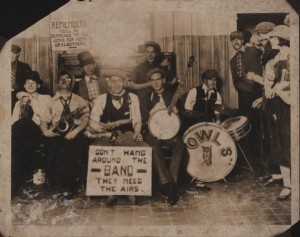LISTEN: Benjie White talks about the “guitar whiz” Snoozer Quinn:

New Orleans Owls (jazz band) at Chess, Checkers and Whist Club, formerly Cosmopolitan Hotel. From left to right: Dick Mackie, Monk Smith, Red Mackie, Benjie White, Rene Gelpi, Earl Crumb, Eblen Rau (standing behind Gelpi). The band and spectators at right are costumed; possibly for costume party or Carnival. This photo and information is from Wikipedia (public domain) and from A Trumpet Around the Corner: The Story of New Orleans Jazz, by Samuel Barclay Charters.
On March 16, 1961, the New Orleans jazz man Benjie (Benji?) White was interviewed by Dick Allen and Paul Crawford at his home in New Orleans (103 Maryland Drive). At one point, White discussed the jazz guitarist Snoozer Quinn, whom he called “a whiz.” I have included an audio excerpt here for your enjoyment. The original interview is held in the oral history collection of the Hogan Jazz Archive at Tulane University.
White was a saxophonist and clarinet player (and he also could play violin) and one of the founding members of the New Orleans Owls.
Here is an entry about the New Orleans Owls on Red Hot Jazz. The Owls are one of the few New Orleans jazz bands recorded in New Orleans in the 1920s.
According to White, the other original members of The Owls were Red Mackie (bass and piano), Dick Mackie (cornet), Monk Smith (tenor sax and guitar), Rene Gelpi (banjo) and Eblen Rau (violin). Other early associates: Eugene “Jinx” Diboll, Fred Ogden, Guy Lyman, Earl Crumb.
Said White: “It’s a funny thing…. When we started playing, there were very few white bands in existence. Most all of them, good jazz bands, were really colored jazz bands. It was a little peculiar feeling for us to break into this jazz feel here, under those conditions… It was, because…except for the fact that most of us had had a year of college or so and were pretty well known in New Orleans….take most of those boys who were with us were from excellent families, … [we] didn’t consider it a livelihood, we considered it a lark. But the thing got control and became a livelihood with us, for quite a number of years.”
LISTEN: New Orleans Owls
Many thanks to the Hogan Jazz Archive for allowing me to post clips from their oral history collection. Bruce Raeburn, Lynn Abbott, and Nicole Shibata have all been wonderful in their assistance on my Snoozer projects.
More info: Wilfred “Benjie” White was born August 30, 1901 in New Orleans. Lived on First Street, Valmont, Pine, 1467 Calhoun Street, Attended LaSalle, Williston in Easthampton, two years at Tulane University in the College of Commerce and Business Administration.
